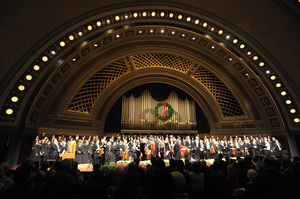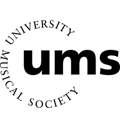
 Something really special about this year's performance of this long-standing Ann Arbor tradition, Handel's Messiah by the UMS choral union, was that the principals of the event all shared a strong connection with Michigan. Three of the four soloists (Caitlin Lynch, Nicholas Phan, and Jesse Blumberg) were actually UM alums., while the fourth, Meredith Arwady, was also a Michigan native -- a resident of Kalamazoo. Two UM music professors were also prominently featured: Edward Parmentiari on the harpsichord, and Jerry Blackstone, conductor and music director.
Something really special about this year's performance of this long-standing Ann Arbor tradition, Handel's Messiah by the UMS choral union, was that the principals of the event all shared a strong connection with Michigan. Three of the four soloists (Caitlin Lynch, Nicholas Phan, and Jesse Blumberg) were actually UM alums., while the fourth, Meredith Arwady, was also a Michigan native -- a resident of Kalamazoo. Two UM music professors were also prominently featured: Edward Parmentiari on the harpsichord, and Jerry Blackstone, conductor and music director.Handel's Messiah has a tripartite structure. Concerned as it is with the story of the "messiah", that is, Christ, Its three sections correspond to "the prophecy", "the passion" and "the resurrection", with the most intense part of the piece consisting of the "Hallelujah" section just before Part II. Traditionally the audience joins in the chorus during the singing of this "Hallelujah" section, and that was the case, too, in this performance. In fact, the University Musical Society actually made the music available to audience members to sing to. The text (oratorio) of Handel's Messiah is actually drawn from various verses of the Bible. The "Hallelujah" sections, for example, are taken from Revelation 19: 6, Revelation 11: 15 and Revelation 19: 16. (By the way, the British Library has made the original score to Messiah, in Handel's own handwriting, available on the Web.)
The stage of the Hill Auditorium was beautifully decorated, with a mass of white poinsettias near the front of the stage and a large wreath hanging from the cavernous ceiling. The red color of the harpsichord was a nice touch.
In performing a work like Handel's Messiah, the elements of the dramatic in the work have to be carefully balanced against the element that expresses piety. This performance, overall, managed to do that well.

No comments:
Post a Comment